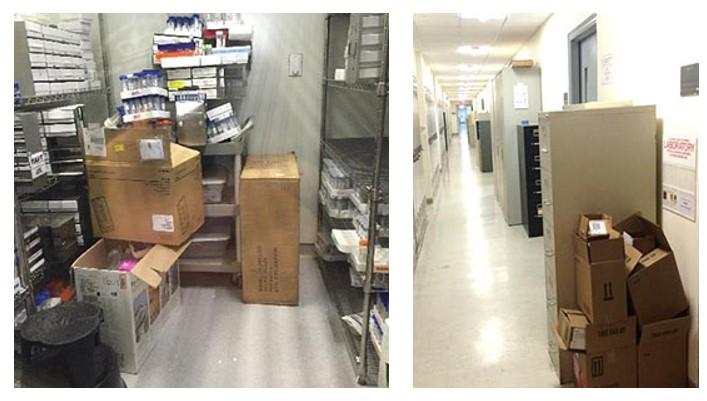FDN(wh)Y Me? 2016
During a regular weekly inspection of Columbia University laboratories, the FDNY fire inspector issued a violation to a lab for exceeding the possession limit for flammable liquids.
In doubt whether your laboratory is in compliance? Keep in mind, flammable liquids have flash points below 100 °F. Examples of the flammable liquids most commonly used in our laboratories are: ethyl ether, acetone, methanol, ethanol, butanol, pentane, hexane, cyclohexane, benzene, toluene and xylene.
It is a safe practice to always check the manufacturer’s label or the Safety Data Sheet to learn the flash point of a certain liquid compound that you are working with. Additionally, you should consult the FDNY laboratory permit posting to determine your laboratory type which dictates the maximum allowable storage limits for flammable liquids. Not sure what the limit is for your laboratory? Please contact a fire safety officer at [email protected] to find out.
When calculating the actual possession volume of those liquids, keep in mind that (for ease of accounting), a partially empty container of a certain flammable is still counted as the full volume of that container. Also, don’t forget to count the volumes of such chemicals in existing waste disposal containers. If you think that all this is a hassle, that the fire safety inspector was too zealous, think again! Imagine the increased risk associated with the large volume of flammable liquids that pose a fire hazard. The combination of high risk (larger than mandated volume) and high fire hazard may result in injury or even loss of life. So, by correctly determining and respecting those possession limits you increase your personal safety and the safety of all working in the laboratory.
Please note, the FDNY Laboratory Safety Unit is on-site weekly at the Morningside and Medical Center campuses. For a consultation before the FDNY inspector gets around to your lab, or for any question, concern, or help, please contact your Research Safety Specialist.
During a regular weekly inspection of Columbia University laboratories, the FDNY fire inspector issued a violation to several laboratories for storing equipment and boxes in laboratory walkways, creating trip hazards and potentially impeding emergency egress. Excessive clutter could also impact access to safety equipment including fire extinguishers, overhead emergency showers, eye wash stations and electrical panels. Remove any furniture, boxes, equipment and other items from the walkways in order to maintain safe egress from the laboratory. The minimum aisle clearance inside a laboratory is 36 inches.
Excess storage of materials in building corridors is also a safety concern and a violation of FDNY fire code. Corridors require a minimum clearance of 44 inches at all times, and should never be used for permanent storage of laboratory equipment, such as refrigerators. Additionally, combustible materials such as cardboard boxes, should not accumulate in corridors for extended periods of time. Items which must be stored in corridors shall be positioned only to one side of the corridor, to allow for safe egress. As a reminder, food and beverages are not permitted in any laboratory spaces, and the storage of shelving and carts for such items is permitted in corridors, in accordance with the above guidelines.
The photos below illustrate examples of unsafe conditions which could result in an FDNY VO.

Please note, the FDNY Laboratory Safety Unit is on-site weekly at the Morningside and Medical Center campuses. For a consultation before the FDNY inspector gets around to your lab, or for any question, concern, or help, please contact your Research Safety Specialist.
During several recent inspections of Columbia University laboratories, the FDNY fire inspector has issued violations to laboratories for improper labeling of the peroxide-forming chemical diethyl ether. As the name implies, peroxide-forming chemicals can form potentially explosive compounds after exposure to oxygen and prolonged storage, and are strictly regulated by the FDNY.
FDNY regulations for peroxide-forming chemicals, such as diethyl ether and tetrahydrofuran (THF), require that these chemicals be dated at the time of opening, and then tested to verify that they are free of peroxides within 6 months of the opening date. After testing, if a laboratory deems the chemical viable for continued use, the lab must write the test date on the chemical container and may retain the chemical for an additional 6 month period, never to exceed 12 months from the original opening date. If a lab determines that a chemical is no longer safe for continued use, or the chemical reaches its expiration date, it must be disposed of as a hazardous waste by submitting the online Chemical Waste Pickup Request http://vesta.cumc.columbia.edu/ehs/wastepickup form.
Columbia University EH&S maintains a list of the most commonly-found peroxide-forming chemicals on campus. The most commonly used, and cited, chemicals, including diethyl ether, are displayed in bold. There are several administrative controls that can be used to stay say and avoid this FDNY violation in your lab:
1. Always date peroxide-forming chemicals when opened; test and date for peroxides within 6 months after opening
2. Routinely inspect your laboratory for peroxide-forming chemicals; properly discard outdated/unwanted chemicals
Please note, the FDNY Laboratory Safety Unit is on-site weekly at the Morningside and Medical Center campuses. For a consultation before the FDNY inspector gets around to your lab, or for any question, concern, or help, please contact your Research Safety Specialist.
